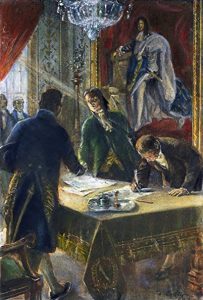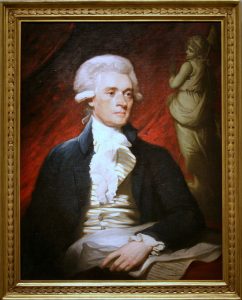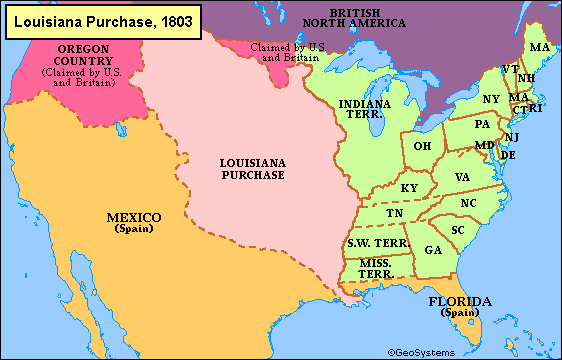Historical Document Analysis
Name of the Document:
Louisiana Purchase in 1803
Date of the Document:
Start date: 1803 and the end date was on April 30, 1803
Historical context/ background/ intent of author

The signing of the Louisiana Purchase treaty. Image source google.com
The Emergent nation era, which occurred from 1790 till 1869, Had one of the most significant historical events, which was the opening to the West, marked later the new nation. Many people start moving to the West, where they were forbidden to settle land over the mountains, and it was a result of the expelling of the British hegemony at that time in 1783.
During this era, expressions like “Go West, young man, and grow up with the country” (Cohen & Kisher, 2010, p. 66) riches people’s minds to have the optimism feeling in the acquisition of new territory. Therefore, the expansion of the manufacturing and settlements started with Louisiana purchase in 1803. Which at that time was a significant and historical event that separated the colonial era from the Emergent nation era as this purchase was considered “a massive land sale that doubles the size of the young American republic” (History.com Editors, 2020).
Louisiana purchase background
As I mentioned earlier in the introduction that the Emergent era had a diffusion and expansion of possessing new territories. Thomas Jefferson’s who took the presidency in 1801 and he was at that time the third president of the United States, played a notable and prominent role during the emergent era in which he was able to make a successful land deal between France and the United States of America—allowing the U.S. to acquire almost 827,000 square miles of land west for $15 million of the Mississippi River.

Thomas Jefferson; The third president of the United States. Image source google.com
Thomas Jefferson had always apprehended the costs of flowing construction of the powers authorized to the national government, and the constitution was quiet to obtain lands from other countries. Jefferson’s vision of territories and America’s farm market expansion was threatened. “Blocking American access to New Orleans was such a grave threat to American interests that President Jefferson considered changing his traditional foreign policy stance to an anti-French alliance with the British” (UShistory.org).
Below is Thomas Jefferson’s prediction; a letter that he wrote among reports referenced that Spain would be back to France the vast territory of Louisiana.
“This little event, of France possessing herself of Louisiana, … is the embryo of a tornado which will burst on the countries on both shores of the Atlantic and involve in its effects their highest destinies” (Monticello.org).
Napoleon wanted to block the American aperture to the New Orleans port on the Mississippi River. However, “in 1801, America learned that Spain had agreed to return Louisiana to France” (Bill of Rights Institute, 2020), and Jefferson knew that by Napoleon’s mission, a crisis would occur to America as the nation depends on New Orleans for its financial continuance for endurance and survival. Accordingly, France revert the power of Louisiana, “new American settlements west of the Appalachian Mountains depended upon river transport to get their goods to market since overland trade to the east was expensive and impractical” (UShistory.org). And when U.S. president Thomas Jefferson sent many diplomats to France and Britain regarding the importance of maintaining and continue the trade access sideways, Mississippi. He received an offer from Napoleon Bonaparte to take all Louisiana territory for fifteen million dollars, although Napoleon’s brothers and ministers opposed and did not support the purchase with the United States. Napoleon needed that money to continue the war against Britain.
According to the Bill of Rights Institute (2020), “The Senate ratified the Louisiana Purchase Treaty in October of 1803”.
The National Archives website provided three transcribed documents that explained the agreement between France and the united states, including cessions and conventions. As referenced by the National Archives and Records Administration, “The Louisiana Purchase consists of three separate agreements between the United States and France: a treaty of cession and two agreements providing for the exchange of monies in the transaction” (1996). The Louisiana purchase treaty was signed on April 30, 1803, by Virginia’s governor, James Monroe, the American minister to France; Robert Livingston and the third person who signed the treaty of Louisiana purchase is the minister of the French treasury, Francois Barbe- Marbois.
Historical Influence/ Influence/
Through conducting much reading on the Louisiana Purchase, I have learned that the Louisiana purchase was described as the most outstanding real estate deal in American history.
It did have a significant historical influence as “the Louisiana Purchase nearly doubled the size of the United States, making it one of the largest nations in the world” (National Archives and Records Administration, 1996); with that purchase of Louisiana Territory, Thomas Jefferson changed the destiny and the map of the United States. Twenty-five states established their first Higher Education institutions from 1794 till 1867. The United States population exploded approximately from five million to twenty-three million in 1850.
Keep in mind that Jefferson pushed the entire nation not only by the size or the physical boundaries but also the vision for what will become the West. However, many controversial issues were raised by the purchase “some New England Federalists, for example, began to talk of seceding from the U.S. since their political power was dramatically reduced by the purchase”( UShistory.org). Also, History.com Editors declared an impact of the Louisiana purchase that “The rapid expansion of the United States intensified the issue of slavery as new states were added to the Union, leading to the outbreak of the Civil War” (2019). Besides, the rapid growth and the two economic depressions in 1819 and 1839 “drive millions of American westwards in search of new land and new opportunities” (UShistory.org).

U.S.A old map: Louisiana Purchase, 1803. Source: pinterest.com
The western expansion was consequently significant to Jefferson’s gross vision that he took bold action by adding thirteen new states to the United States of America. Out of the U.S. empire were carved states of Louisiana, Missouri, Arkansas, Iowa, North Dakota, South Dakota, Nebraska, Oklahoma, Kansas, Colorado, Wyoming, Montana, and Minnesota.
“Much of the West became part of the United States through the Louisiana Purchase of 1803” (Britannica, 2020).
Louisiana was the first to enter the U.S. with maintaining the French tradition; even today, many Louisiana elements do not follow English law tradition. The Louisiana purchase led to the homestead act, which enables people to purchase lands for meager prices.
Finally, Thomas Jefferson, who led to the acquisition of Louisiana territory, achieves a political and economic victory by gaining over 600 million acres at less than 4¢ an acre, which also averted a contingent war with the French. It added a path to the country for the international market for all American farm products. It strengthened the entire union by providing a powerful motive to westward expansion and authenticated the doctrine of implicit powers of the federal constitution (Britannica, 2020).
References
- Bill of Rights Institute. (2020). Jefferson and the Louisiana Purchase. Retrieved September 20, 2020, from https://billofrightsinstitute.org/educate/educator-resources/lessons-plans/presidents-constitution/louisiana-purchase/?gclid=EAIaIQobChMIrq7q7qP46wIVE9bACh3WhgDSEAAYASAAEgJ9jfD_BwE
- Cohen, A. M., & Kisher, C. B. (2010). The Shaping of American Higher Education: Emergence and Growth of the Contemporary System (2nd ed.). Jossey-Bass. eISBN : 978-0-470-55166-0 https://ebooks1.net/?download_file=279229&order=wc_order_hiCu0y9gDw45s&uid=7f5f5813f6cd109242a3452027938a675d920e9faff8859e2525a1f104820e46&key=732b0ff4-baf9-473e-a07c-bb557a49e57b
- National Archives and Records Administration. (1996). American Originals: The Louisiana Purchase Page. Retrieved September 15, 2020, from https://www.archives.gov/exhibits/american_originals/louistxt.html
- History.com Editors. (2020). History: United States and France conclude the Louisiana Purchase. Retrieved September 18, 2020, from https://www.history.com/this-day-in-history/louisiana-purchase-concluded
- Monticello.org. (n.d.). The Louisiana Purchase. Retrieved September 18, 2020, from https://www.monticello.org/thomas-jefferson/louisiana-lewis-clark/the-louisiana-purchase/
- UShistory.org. (n.d.). Pre Columbian to the New Millennium. Westward Expansion: The Louisiana Purchase. Retrieved September 20, 2020, from https://www.ushistory.org/US/20c.asp
- Britannica. (2020). Louisiana Purchase: United States history. Retrieved September 20, 2020, from https://www.britannica.com/event/Louisiana-Purchase
- History.com Editors. (2019). History: Manifest Destiny. Retrieved October 24, 2020, from https://www.history.com/topics/westward-expansion/manifest-destiny
Leave a Reply